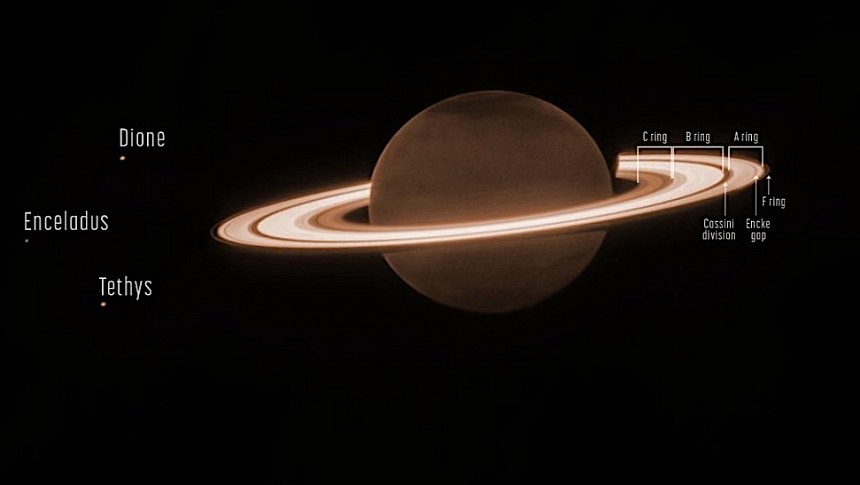The James Webb Space Telescope (JWST) has been spying on the solar system and the wider Universe for more than a year now, and the world can't stop being amazed at the amount, quality, and importance of the science it returns. Case in point, (probably) the most exciting image of Saturn you've ever seen.
There is little doubt the most exciting images Webb sent back these past few months show the larger Universe in all its glory. But even when it's pointed at our own solar system, a neighborhood we like to think we know by heart, it literally shines new light on our assumptions.
At the end of June, the telescope turned its Near-Infrared Camera camera toward gas giant Saturn. In doing so it managed to snap its first-ever infrared pics of the fascinating world, making it glow to the human eye in colors and ways never seen before.
The main image of this piece is what I'm talking about. It's not edited or enhanced in any way, but shows Saturn and its glorious rings in amazing colors.
The planet itself appears dark in the infrared image and according to NASA that's owed to the methane on the planet absorbing sunlight that hits the atmosphere.
As you see the planet now, Saturn is experiencing summer in the northern hemisphere and the end of winter in the south, and that's possibly one of the reasons that the northern side appears to be a tad darker.
Contrasting the planet's darkness, the rings shine in an unusually bright orange glow, as if someone turned on light strips. In reality, we're looking at rocky and icy fragments shining in the sunlight.
A really, really close look at the photo also reveals some of the Saturn's moons, namely Dione, Enceladus, and Tethys. Enceladus was recently in the news thanks to an exciting discovery: traces of phosphorus, which is one of the building blocks for DNA as we know it.
The image was taken as part of a larger program that will see the Webb turn its attention some more in the coming months. The goal of the program is to find "faint moons around the planet and its bright rings," in a bid to get a "more complete picture of the current system of Saturn, as well as its past."
The scientists behind this particular program are also hopeful further images of the distant world might also reveal some fainter rings, the ones that are not visible in this pic.
Saturn is the sixth planet from the Sun in our solar system. It spins on its orbit at a distance of 793 million miles (1.37 billion km) from Earth. It's so large in diameter it could fit nine Earths placed next to each other, and it takes it 29 Earth years to complete an orbit around the Sun.
At the time of writing, we know of 82 moon circling the gas giant (29 of them are still waiting for official designation as a moon), while its ring system comprises seven main rings.
The planet has been the subject of study for three spacecraft: Voyager 1, Voyager 2, and Cassini. The latter was specifically sent to take a long look at the place, orbiting the planet 294 times between 2004 and 2017.
At the end of June, the telescope turned its Near-Infrared Camera camera toward gas giant Saturn. In doing so it managed to snap its first-ever infrared pics of the fascinating world, making it glow to the human eye in colors and ways never seen before.
The main image of this piece is what I'm talking about. It's not edited or enhanced in any way, but shows Saturn and its glorious rings in amazing colors.
The planet itself appears dark in the infrared image and according to NASA that's owed to the methane on the planet absorbing sunlight that hits the atmosphere.
As you see the planet now, Saturn is experiencing summer in the northern hemisphere and the end of winter in the south, and that's possibly one of the reasons that the northern side appears to be a tad darker.
Contrasting the planet's darkness, the rings shine in an unusually bright orange glow, as if someone turned on light strips. In reality, we're looking at rocky and icy fragments shining in the sunlight.
A really, really close look at the photo also reveals some of the Saturn's moons, namely Dione, Enceladus, and Tethys. Enceladus was recently in the news thanks to an exciting discovery: traces of phosphorus, which is one of the building blocks for DNA as we know it.
The image was taken as part of a larger program that will see the Webb turn its attention some more in the coming months. The goal of the program is to find "faint moons around the planet and its bright rings," in a bid to get a "more complete picture of the current system of Saturn, as well as its past."
The scientists behind this particular program are also hopeful further images of the distant world might also reveal some fainter rings, the ones that are not visible in this pic.
Saturn is the sixth planet from the Sun in our solar system. It spins on its orbit at a distance of 793 million miles (1.37 billion km) from Earth. It's so large in diameter it could fit nine Earths placed next to each other, and it takes it 29 Earth years to complete an orbit around the Sun.
At the time of writing, we know of 82 moon circling the gas giant (29 of them are still waiting for official designation as a moon), while its ring system comprises seven main rings.
The planet has been the subject of study for three spacecraft: Voyager 1, Voyager 2, and Cassini. The latter was specifically sent to take a long look at the place, orbiting the planet 294 times between 2004 and 2017.







